Hitachi WH41DMR, WH18DL, WH14DL, WH18DMR User Manual
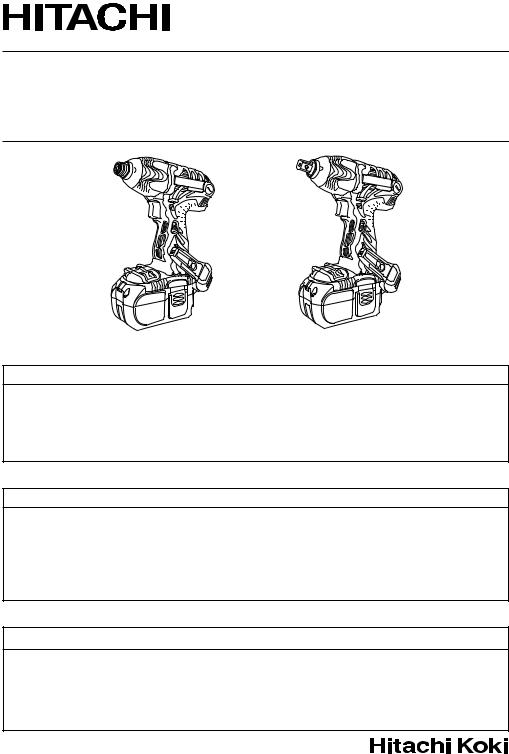
Model
Modèle
Modelo
WH 14DMR•WH 14DL•WH 18DMR•WH 18DL
WR 14DMR• WR 14DL•WR 18DMR• WR 18DL
Cordless Impact Driver Visseuse à percussion à batterie Atornillador de impacto a battería
Cordless Impact Wrench Clé à choc à batterie Llave de impacto a batería
WH18DL |
WR18DL |
SAFETY INSTRUCTIONS AND INSTRUCTION MANUAL
WARNING
IMPROPER OR UNSAFE use of this power tool can result in death or serious bodily injury! This manual contains important information about product safety. Please read and understand this manual BEFORE operating the power tool. Please keep this manual available for other users and owners before they use the power tool. This manual should be stored in safe place.
INSTRUCTIONS DE SECURITE ET MODE D’EMPLOI
AVERTISSEMENT
Une utilisation INCORRECTE OU DANGEREUSE de cet outil motorisé peut entraîner la mort ou de sérieuses blessures corporelles !
Ce mode d’emploi contient d’importantes informations à propos de la sécurité de ce produit. Prière de lire et de comprendre ce mode d’emploi AVANT d’utiliser l’outil motorisé. Garder ce mode d’emploi à la disponibilité des autres utilisateurs et propriétaires avant qu’ils utilisent l’outil motorisé. Ce mode d’emploi doit être conservé dans un endroit sûr.
INSTRUCCIONES DE SEGURIDAD Y MANUAL DE INSTRUCCIONES
ADVERTENCIA
¡La utilización INAPROPIADA O PELIGROSA de esta herramienta eléctrica puede resultar en lesiones de gravedad o la muerte!
Este manual contiene información importante sobre la seguridad del producto. Lea y comprenda este manual ANTES de utilizar la herramienta eléctrica. Guarde este manual para que puedan leerlo otras personas antes de utilizar la herramienta eléctrica. Este manual debe ser guardado en un lugar seguro.

CONTENTS
English
Page |
Page |
IMPORTANT SAFETY INFORMATION ................ |
3 |
MEANINGS OF SIGNAL WORDS ........................ |
3 |
SAFETY ...................................................................... |
3 |
GENERAL SAFETY RULES – FOR ALL BATTERY |
|
OPERATED TOOLS ........................................ |
3 |
SPECIFIC SAFETY RULES .................................... |
4 |
IMPORTANT SAFETY INSTRUCTIONS FOR USE |
|
OF THE CORDLESS IMPACT DRIVER / |
|
WRENCH ........................................................ |
5 |
IMPORTANT SAFETY INSTRUCTIONS FOR |
|
BATTERY CHARGER ...................................... |
5 |
IMPORTANT SAFETY INSTRUCTIONS |
|
FOR USE OF THE BATTERY AND |
|
BATTERY CHARGER ...................................... |
6 |
CAUTION ON LITHIUM–ION BATTERY ............... |
6 |
FUNCTIONAL DESCRIPTION .................................... |
7 |
SPECIFICATIONS .................................................. |
7 |
ASSEMBLY AND OPERATION ................................. |
8 |
REMOVAL AND INSTALLATION METHOD OF |
|
BATTERY ........................................................ |
8 |
CHARGING METHOD ........................................... |
8 |
OPERATION ......................................................... |
10 |
OPERATIONAL CAUTIONS ................................ |
12 |
MAINTENANCE AND INSPECTION ....................... |
13 |
ACCESSORIES ......................................................... |
15 |
STANDARD ACCESSORIES ............................... |
15 |
PARTS LIST .............................................................. |
44 |
|
|
TABLE DES MATIERES |
|
Français |
|
|
|
|
Page |
Page |
|
|
|
INFORMATIONS IMPORTANTES |
|
DE SÉCURITÉ ............................................... |
16 |
SIGNIFICATION DES MOTS |
|
D’AVERTISSEMENT .................................... |
16 |
SECURITE ................................................................ |
16 |
REGLES GENERALE DE SECURITE – POUR TOUS |
|
LES OUTILS FONCTIONNANT SUR |
|
BATTERIE ..................................................... |
16 |
REGLES DE SECURITE SPECIFIQUES ............... |
17 |
CONSIGNES DE SÉCURITÉ IMPORTANTES |
|
POUR L'UTILISATION DU VISSEUSE / CLÉ Á |
|
CHOC À PERCUSSION À BATTERIE .......... |
18 |
CONSIGNES DE SÉCURITÉ IMPORTANTES |
|
POUR LE CHARGEUR DE BATTERIE .......... |
19 |
CONSIGNES DE SÉCURITÉ IMPORTANTES |
|
POUR L’UTILISATION DE LA BATTERIE ET |
|
DU CHARGEUR DE BATTERIE .................... |
19 |
PRÉCAUTIONS RELATIVES A LA BATTERIE AU |
|
LITHIUM ION ................................................ |
20 |
DESCRIPTION FONCTIONNELLE ........................... |
21 |
SPECIFICATIONS ................................................ |
21 |
ASSEMBLAGE ET FONCTIONNEMENT ................ |
22 |
MÉTHODE DE RETRAIT ET D’INSTALLATION |
|
DE LA BATTERIE .......................................... |
22 |
MÉTHODE DE RECHARGE ................................. |
22 |
UTILISATION ....................................................... |
24 |
PRECAUTIONS D'UTILISATION ........................ |
27 |
ENTRETIEN ET INSPECTION .................................. |
28 |
ACCESSOIRES ......................................................... |
29 |
ACCESSOIRES STANDARD ............................... |
29 |
LISTA DES PIÉCES .................................................. |
44 |
ÍNDICE
Español
Página |
Página |
INFORMACIÓN IMPORTANTE SOBRE |
|
SEGURIDAD ................................................. |
30 |
SIGNIFICADO DE LAS PALABRAS DE |
|
SEÑALIZACIÓN ............................................ |
30 |
SEGURIDAD ............................................................. |
30 |
NORMAS GENERALES DE SEGURIDAD – PARA |
|
TODAS LAS HERRAMIENTAS |
|
ALIMENTADAS CON BATERÍA ................... |
30 |
NORMAS ESPECÍFICOS DE SEGURIDAD ......... |
31 |
INSTRUCCIONES IMPORTANTES PARA LA |
|
UTILIZACIÓN DEL ATORNILLADORES / |
|
LLAVE DE IMPACTO A BATERÍA ................ |
32 |
INSTRUCCIONES IMPORTANTES DE |
|
SEGURIDAD PARA EL CARGADOR DE |
|
BATERÍAS ............................................... |
33 |
INSTRUCCIONES IMPORTANTES DE |
|
SEGURIDAD PARA LA BATERÍA Y EL |
|
CARGADOR DE BATERÍAS ......................... |
33 |
ADVERTENCIA DE LA BATERÍA DE LITIO ......... |
34 |
DESCRIPCIÓN FUNCIONAL .................................... |
35 |
ESPECIFICACIONES ............................................ |
35 |
MONTAJE Y OPERACIÓN ...................................... |
36 |
MÉTODO DE EXTRACCIÓN E INSTALACIÓN |
|
DE LA BATERÍA ............................................ |
36 |
MÉTODO DE CARGA .......................................... |
36 |
OPERACIÓN ........................................................ |
38 |
PRECAUCIONES OPERACIONALES .................. |
41 |
MANTENIMIENTO E INSPECCIÓN ........................ |
42 |
ACCESSOIRES ......................................................... |
43 |
ACCESORIOS ESTÁNDAR ................................. |
43 |
LISTA DE PIEZAS .................................................... |
44 |
2

English
IMPORTANT SAFETY INFORMATION
Read and understand all of the safety precautions, warnings and operating instructions in the Instruction Manual before operating or maintaining this power tool.
Most accidents that result from power tool operation and maintenance are caused by the failure to observe basic safety rules or precautions. An accident can often be avoided by recognizing a potentially hazardous situation before it occurs, and by observing appropriate safety procedures.
Basic safety precautions are outlined in the “SAFETY” section of this Instruction Manual and in the sections which contain the operation and maintenance instructions.
Hazards that must be avoided to prevent bodily injury or machine damage are identified by WARNINGS on the power tool and in this Instruction Manual.
NEVER use this power tool in a manner that has not been specifically recommended by HITACHI.
MEANINGS OF SIGNAL WORDS
WARNING indicates a potentially hazardous situations which, if ignored, could result in death or serious injury.
CAUTION indicates a potentially hazardous situations which, if not avoided, may result in minor or moderate injury, or may cause machine damage.
NOTE emphasizes essential information.
SAFETY
GENERAL SAFETY RULES – FOR ALL BATTERY OPERATED TOOLS
WARNING:
Read and understand all instructions.
Failure to follow all instructions listed below, may result in electric shock, fire and/or serious personal injury.
SAVE THESE INSTRUCTIONS
1.Work Area
(1)Keep your work area clean and well lit. Cluttered benches and dark areas invite accidents.
(2)Do not operate power tools in explosive atmospheres, such as in the presence of flammable liquids, gases, or dust. Power tools create sparks which may ignite the dust of fumes.
(3)Keep bystanders, children and visitors away while operating a power tool. Distractions can cause you to lose control.
2.Electrical Safety
(1)A battery operated tool with integral batteries or a separate battery pack must be recharged only with the specified charger for the battery. A charger that may be suitable for one type of battery may create a risk of fire when used with another battery.
(2)Use battery operated tool only with specifically designed battery pack. Use of any other batteries may create a risk of fire.
3.Personal Safety
(1)Stay alert, watch what you are doing and use common sense when operating a power tool. Do not use tool while tired or under the influence of drugs, alcohol, or medication. A moment of inattention while operating power tools may result in serious personal injury.
(2)Dress properly. Do not wear loose clothing or jewelry. Contain long hair. Keep your hair, clothing and gloves away from moving parts. Loose clothes, jewelry, or long hair can be caught in moving parts.
(3)Avoid accidental starting. Be sure switch is off position before inserting battery. Carrying tools with your finger on the switch or inserting the battery pack into a tool with the switch on invites accidents.
(4)Remove adjusting keys or wrenches before turning the tool on. A wrench or a key that is left attached to a rotating part of the tool may result in personal injury.
(5)Do not overreach. Keep proper footing and balance at all times. Proper footing and balance enable better control of the tool in unexpected situations.
(6)Use safety equipment. Always wear eye protection. Dust mask, non-skid safety shoes, hard hat, or hearing protection must be used for appropriate conditions.
4.Tool Use and Care
(1)Use clamps or other practical way to secure and support the workpiece to a stable platform. Holding the work by hand or against your body is unstable and may lead to loss of control.
(2)Do not force tool. Use the correct tool for your application. The correct tool will do the job better and
safer at the rate for which it is designed. |
3 |

English
(3)Do not use tool if switch does not turn it on or off. Any tool that cannot be controlled with the switch is dangerous and must be repaired.
(4)Disconnect battery pack from tool or place the switch in the locked or off position before making any adjustments, changing accessories, or storing the tools. Such preventive safety measures reduce the risk of starting the tool accidentally.
(5)Store idle tools out of reach of children and other untrained persons. Tools are dangerous in the hands of untrained users.
(6)When battery pack is not in use, keep it away from other metal objects like: paper clips, coins, keys, nails, screws, or other small metal objects that can make a connection from one terminal to another.
Shorting the battery terminals together may cause sparks, burns, or a fire.
(7)Maintain tools with care. Keep cutting tools sharp and clean. Properly maintained tools, with sharp cutting edges are less likely to bind and are easier to control.
(8)Check for misalignment or binding of moving parts, breakage of parts, and any other condition that may affect the tools operation. If damaged, have the tool serviced before using. Many accidents are caused by poorly maintained tools.
(9)Use only accessories that are recommended by the manufacturer for your model. Accessories that may be suitable for one tool, may become hazardous when used on another tool.
5.Service
(1)Tool service must be performed only by qualified repair personnel. Service or maintenance performed by unqualified personnel could result in a risk of injury.
(2)When servicing a tool, use only identical replacement parts. Follow instructions in the Maintenance section of this manual. Use of unauthorized parts or failure to follow Maintenance Instruction may create a risk of electric shock or injury.
WARNING:
Some dust created by power sanding, sawing, grinding, drilling, and other construction activities contains chemicals known to the State of California to cause cancer, birth defects or other reproductive harm. Some examples of these chemicals are:
●Lead from lead-based paints,
●Crystalline silica from bricks and cement and other masonry products, and
●Arsenic and chromium from chemically-treated lumber.
Your risk from these exposures varies, depending on how often you do this type of work. To reduce your exposure to these chemicals: work in a well ventilated area, and work with approved safety equipment, such as those dust masks that are specially designed to filter out microscopic particles.
SPECIFIC SAFETY RULES
1.Hold tools by insulated gripping surfaces when performing an operation where the cutting tool may contact hidden wiring. Contact with a “live” wire will make exposed metal parts of the tool “live” and shock the operator.
2.Never touch moving parts.
Never place your hands, fingers or other body parts near the tool’s moving parts.
3.Never operate without all guards in place.
Never operate this tool without all guards or safety features in place and in proper working order. If maintenance or servicing requires the removal of a guard or safety feature, be sure to replace the guard or safety feature before resuming operation of the tool.
4.Use right tool.
Don’t force small tool or attachment to do the job of a heavy-duty tool.
Don’t use tool for purpose not intended —for example— don’t use circular saw for cutting tree limbs or logs.
5.Never use a power tool for applications other than those specified.
Never use a power tool for applications other than those specified in the Instruction Manual.
6.Handle tool correctly.
Operate the tool according to the instructions provided herein. Do not drop or throw the tool. Never allow the tool to be operated by children, individuals unfamiliar with its operation or unauthorized personnel.
7.Definitions for symbols
|
V ................. |
volts |
no .................... |
no load speed |
|
— ................ |
direct current |
---/min ............. |
revolutions or reciprocation per minute |
8. |
--- |
|
|
|
Keep all screws, bolts and covers tightly in place. |
|
|||
|
Keep all screws, bolts, and plates tightly mounted. Check their condition periodically. |
|||
9. |
Do not use power tools if the plastic housing or handle is cracked. |
|||
|
Cracks in the tool’s housing or handle can lead to electric shock. Such tools should not be used until repaired. |
|||
4

English
10.Blades and accessories must be securely mounted to the tool.
Prevent potential injuries to yourself or others. Blades, cutting implements and accessories which have been mounted to the tool should be secure and tight.
11.Never use a tool which is defective or operating abnormally.
If the tool appears to be operating unusually, making strange noises, or otherwise appears defective, stop using it immediately and arrange for repairs by a Hitachi authorized service center.
12.Carefully handle power tools.
Should a power tool be dropped or struck against hard materials inadvertently, it may be deformed, cracked, or damaged.
13.Do not wipe plastic parts with solvent.
Solvents such as gasoline, thinner, benzine, carbon tetrachloride and alcohol may damage and crack plastic parts. Do not wipe them with such solvents.
Wipe plastic parts with a soft cloth lightly dampened with soapy water and dry thoroughly.
IMPORTANT SAFETY INSTRUCTIONS FOR USE OF THE CORDLESS IMPACT DRIVER / WRENCH
WARNING:
Death or serious bodily injury could result from improper or unsafe use of the cordless impact driver. To avoid these risks, follow these basic safety instructions:
1.Never use this tool handle for any application other than those in this manual.
2.Never place hands or other body parts near the drill bit or chuck during operation. Hold the impact driver by its handle only.
3.When working in high places, always make sure that there is no one below before starting to work.
4.Always wear eye and ear protection when you work.
5.Always install the driver bit securely. A loose bit is dangerous because it can come loose while you are working. (Impact driver)
6.Always use the driver bit that matches the screw size. (Impact driver)
7.Always have the screw you are screwing in and this impact driver in a straight line. Working with this impact driver at an angle to the screw can damage the screw head and will not give the prescribed tightening torque. (Impact driver)
8.Confirm whether the socket has any crack in it. (Impact wrench)
9.Attach the hex. socket securely onto the anvil. If the hex. socket is insufficiently secured, it may drop out and cause an accident. For hex. socket attachment refer to “OPERATION”.
10.Confirm the tightening torque by a torque wrench before use in order to ascertain the correct tightening torque to be used. (Impact wrench)
11.If a universal joint is used, be sure not to operate the unit in a no-load condition. Operating in this condition is dangerous. When the socket section spins around it may cause injury to hands or bodies, or the resulting intense vibration may cause the user to drop the tool. (Impact wrench)
12.Be careful that foreign matters do not block the holes located on both sides of the handle. Also do not close the holes with a tape. The holes act an important role. (Impact wrench)
IMPORTANT SAFETY INSTRUCTIONS FOR BATTERY CHARGER
1.This manual contains important safety and operating instructions for battery charger Model UC14YFA or UC24YFA, UC18YG or UC18YRL.
2.Before using battery charger, read all instructions and cautionary markings on (1) battery charger, (2) battery, and (3) product using battery.
3.To reduce risk of injury, charge HITACHI rechargeable battery type EB7, EB9, EB12, EB14, EB18 series, EBL1430 and EBM1830. Other type of batteries may burst causing personal injury and damage.
4.Do not expose battery charger to rain or snow.
5.Use of an attachment not recommended or sold by the battery charger manufacturer may result in a risk of fire, electric shock, or injury to persons.
6.To reduce risk of damage to electric plug and cord, pull by plug when disconnecting battery charger.
7.Make sure cord is located so that it will not be stepped on, tripped over, or otherwise subjected to damage or stress.
8.An extension cord should not be used unless absolutely necessary. Use of improper extension cord could result in a risk of fire and electric shock.
If extension cord must be used make sure:
a.That blades of extension cord are the same number, size, and shape as those of plug on battery charger;
b.That extension cord is properly wired and in good electrical condition; and
c.That wire size is large enough for AC ampere rating of battery charger as specified in Table 1.
5

English
Table 1
RECOMMENDED MINIMUM AWG SIZE FOR EXTENSION CORDS FOR BATTERY CHARG-
ERS
AC Input Rating Amperes* |
|
AWG Size of Cord |
|
||
Equal to or |
but less |
|
Length of Cord, Feet (Meter) |
|
|
greater than |
than |
25 (7.5) |
50 (15) |
100 (30) |
150 (45) |
0 |
2 |
18 |
18 |
18 |
16 |
2 |
3 |
18 |
18 |
16 |
14 |
3 |
4 |
18 |
18 |
16 |
14 |
*If the input rating of a battery charger is given in watts rather than in amperes, the corresponding ampere rating is to be determined by dividing the wattage rating by the voltage rating–for example:
1,250 watts = 10 amperes
125 volts
9. Do not operate battery charger with damaged cord or plug – replace them immediately.
10. Do not operate battery charger if it has received a sharp blow, been dropped, or otherwise damaged in any way; take it to a qualified serviceman.
11. Do not disassemble battery charger; take it to a qualified serviceman when service or repair is required. Incorrect reassembly may result in a risk of electric shock or fire.
12. To reduce risk of electric shock, unplug charger from receptacle before attempting any maintenance or cleaning. Removing the battery will not reduce this risk.
IMPORTANT SAFETY INSTRUCTIONS FOR USE OF THE BATTERY AND BATTERY CHARGER
You must charge the battery before you can use the cordless impact wrench. Before using the model UC14YFA or UC24YFA or UC18YG or UC18YRL battery charger, be sure to read all instructions and cautionary statements on it, the battery and in this manual.
REMEMBER: USE ONLY HITACHI BATTERY TYPES EB7 SERIES, EB9 SERIES, EB12 SERIES, EB14 SERIES. EB18 SERIES, EBL1430 AND EBM1830. OTHER TYPES OF BATTERIES MAY BURST AND CAUSE INJURY!
Follow these instructions to avoid the risk of injury:
WARNING:
Improper use of the battery or battery charger can lead to serious injury. To avoid these injuries:
1.NEVER disassemble the battery.
2.NEVER incinerate the battery, even if it is damaged or is completely worn out. The battery can explode in a fire.
3.NEVER short-circuit the battery.
4.NEVER insert any objects into the battery charger’s air vents. Electric shock or damage to the battery
charger may result.
5.NEVER charge outdoors. Keep the battery away from direct sunlight and use only where there is low
humidity and good ventilation.
6.NEVER charge when the temperature is below 32°F (0°C) or above 104°F (40°C).
7.NEVER connect two battery chargers together.
8.NEVER insert foreign objects into the hole for the battery or the battery charger.
9.NEVER use a booster transformer when charging.
10.NEVER use an engine generator or DC power to charge.
11.NEVER store the battery or battery charger in places where the temperature may reach or exceed 104°F (40°C).
12.ALWAYS operate charger on standard household electrical power (120 volts). Using the charger on any
other voltage may overheat and damage the charger.
13.ALWAYS wait at least 15 minutes between charges to avoid overheating the charger.
14.ALWAYS disconnect the power cord from its receptacle when the charger is not in use.
CAUTION ON LITHIUM-ION BATTERY
To extend the lifetime, the lithium-ion battery equips with the protection function to stop the output.
In the cases of 1 and 2 described below, when using this product, even if you are pulling the switch, the motor may stop. This is not the trouble but the result of protection function.
1.When the battery power remaining runs out, the motor stops. In such case, charge it up immediately.
2.If the tool is overloaded, the motor may stop. In this case, release the switch of tool and eliminate causes of overloading. After that, you can use it again.
6

English
SAVE THESE INSTRUCTIONS
FUNCTIONAL DESCRIPTION
NOTE: The information contained in this Instruction Manual is designed to assist you in the safe operation and maintenance of the power tool.
NEVER operate, or attempt any maintenance on the tool unless you have first read and understood all safety instructions contained in this manual.
Some illustrations in this Instruction Manual may show details or attachments that differ from those on your own power tool.
SPECIFICATIONS
1.Cordless Impact Driver
Model |
|
WH14DMR |
WH14DL |
WH18DMR |
WH18DL |
Voltage |
|
14.4V |
18V |
||
No-Load speed |
Power mode |
|
0 – 2600 min-1 |
|
|
|
Save mode |
|
0 – 2000 min-1 |
|
|
Capacity (Ordinary bolt) |
|
|
M6 – M14 |
|
|
Tightening torque |
Power mode |
1,240 in-lbs (140 N·m) |
1,330 in-lbs (150 N·m) |
||
(Maximum) |
Save mode |
670 in-lbs (75 N·m) |
710 in-lbs (80 N·m) |
||
|
2.0 Ah |
EB14B:Ni-Cd |
x |
EB1820L: Ni-Cd |
x |
Rechargeable battery |
3.0 Ah |
EB1430H: Ni-MH |
EBL1430: Li-ion *1 |
EB1830H: Ni-MH |
EBM1830: Li-ion *2 |
|
3.3 Ah |
EB1433X: Ni-MH |
x |
EB1833X: Ni-MH |
x |
Weight |
|
3.9 lbs (1.8 Kg) |
3.3 lbs (1.5 Kg) |
4.4 lbs (2.0 Kg) |
3.5 bs (1.6 Kg) |
|
|
|
|
|
|
*1: WH14DL use only with battery EBL1430. *2: WH18DL use only with battery EBM1830.
2.Cordless Impact Wrench
Model |
|
WR14DMR |
WR14DL |
WR18DMR |
WR18DL |
Voltage |
|
14.4V |
18V |
||
No-Load speed |
Power mode |
|
0 – 2600 min-1 |
|
|
|
Save mode |
|
0 – 2000 min-1 |
|
|
Capacity (Ordinary bolt) |
|
|
M10 – M16 |
|
|
Tightening torque |
Power mode |
1,780 in-lbs (200 N·m) |
1,950 in-lbs (220 N·m) |
||
(Maximum) |
Save mode |
980 in-lbs (110 N·m) |
1,070 in-lbs (120 N·m) |
||
|
|||||
|
2.0 Ah |
EB14B:Ni-Cd |
x |
EB1820L: Ni-Cd |
x |
Rechargeable battery |
3.0 Ah |
EB1430H: Ni-MH |
EBL1430: Li-ion *1 |
EB1830H: Ni-MH |
EBM1830: Li-ion *2 |
|
3.3 Ah |
EB1433X: Ni-MH |
x |
EB1833X: Ni-MH |
x |
Weight |
|
3.9 lbs (1.8 Kg) |
3.3 lbs (1.5 Kg) |
4.4 lbs (2.0 Kg) |
3.5 bs (1.6 Kg) |
|
|
|
|
|
|
*1: WH14DL use only with battery EBL1430. *2: WH18DL use only with battery EBM1830.
3. Charger
Model |
|
|
UC14YFA |
UC24YFA |
UC18YG |
UC18YRL |
Charging voltage |
|
|
7.2 – 14.4 V |
7.2 – 24 V |
7.2 – 18 V |
7.2 – 18 V |
|
2.0 |
Ah : Ni-Cd |
50 min. |
50 min. |
50 min. |
30 min. |
|
2.6 |
Ah : Ni-MH |
65 min. |
65 min. |
x |
40 min. |
Charging time |
3.0 Ah : Ni-MH |
70 min. |
70 min. |
x |
45 min. |
|
|
3.3 |
Ah : Ni-MH |
75 min. |
75 min. |
x |
50 min. |
|
3.0 |
Ah : Li-ion |
x |
x |
x |
45 min. |
Weight |
|
|
1.3 lbs. (0.6 Kg) |
1.3 lbs. (0.6 Kg) |
0.7 lbs. (0.3 Kg) |
1.3 lbs. (0.6 Kg) |
|
|
|
|
|
|
|
All charge times are approximate. Actual charge time may vary.
“x” Indicates that the battery pack is not compatible with that specific charger.
7
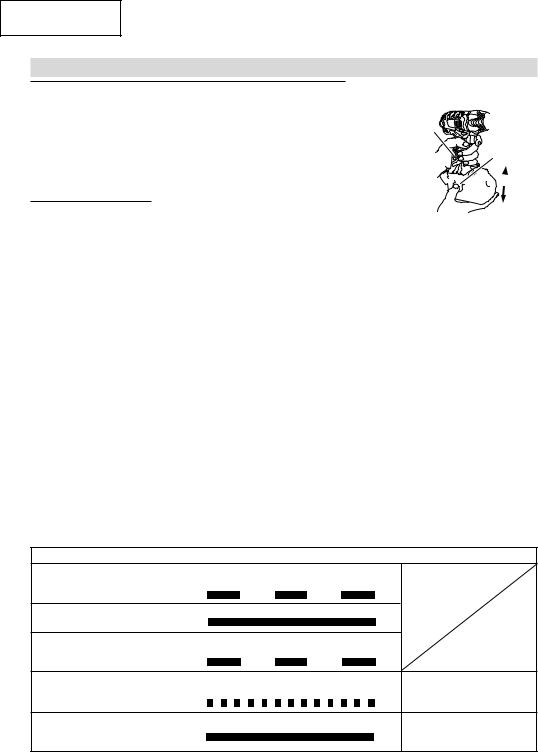
English
ASSEMBLY AND OPERATION
REMOVAL AND INSTALLATION METHOD OF BATTERY
How to install the battery
Align the battery with the groove in tool handle and slip it into place. Always insert it all the way until it locks in place with a little click. If not, it may accidentally fall out of the tool, causing injury to you or someone around you. (Fig. 1)
How to remove the battery
Withdraw battery from the tool handle while pressing the latch on the side of the battery. (Fig. 1)
Handle
Latch
Insert
Battery 



CHARGING METHOD |
Pull out |
NOTE: Before plugging into the receptacle, make sure the following points. |
Fig. 1 |
The power source voltage is stated on the nameplate. |
|
The cord is not damaged. |
|
WARNING:
Do not charge at voltage higher than indicated on the nameplate.
If charged at voltage higher than indicated on the nameplate, the charger will burn up.UC14YFA, UC24YFA, UC18YRL
1.Insert the plug of battery charger into the receptacle
When the plug of battery charger has been inserted into the receptacle, pilot lamp will blink in red. (At 1-second intervals)
WARNING:
Do not use the electrical cord if damaged. Have it repaired immediately.
2.Insert the battery to the battery charger
Insert the battery into the battery charger. Make sure it contacts the bottom of the battery charger.
CAUTION:
●If the batteries are inserted in the reverse direction, not only recharging will become impossible, but it may also cause problems in the charger such as a deformed recharging terminal.
3.Charging
When the battery is connected to the battery charger, charging will commence and the pilot lamp will light in red. (See Table 2)
NOTE: If the pilot lamp flickers in red, pull out the plug from the receptacle and check if the battery is properly mounted. When the battery is fully charged, the pilot lamp will blink in red slowly. (At 1-second intervals) (See Table 2)
(1)Pilot lamp indication
The indications of the pilot lamp will be as shown in Table 2, according to the condition of the charger or the rechargeable battery.
Table 2
Before |
Blinks |
charging |
(RED) |
While |
Lights |
charging |
(RED) |
Charging |
Blinks |
complete |
(RED) |
Charging |
Flickers |
impossible |
(RED) |
Charging |
Lights |
impossible |
(GREEN) |
|
|
Indications of the lamps
Lights for 0.5 seconds. Does not light for 0.5 seconds. (off for 0.5 seconds)
Lights continuously
Lights for 0.5 seconds. Does not light for 0.5 seconds. (off for 0.5 seconds)
Lights for 0.1 seconds. Does not light for 0.1 seconds. (off for 0.1 seconds)
Lights continuously
Malfunction in the battery or the charger.
The battery temperature is high, making recharging impossible.
NOTE: When standby for cooling battery, UC18YRL cools the overheated battery by cooling fan.
8

English
(2)Regarding the temperature of the rechargeable battery.
The temperatures for rechargeable batteries are as shown in the table below, and batteries that have become hot should be cooled for a while before being recharged.
Table 3 Recharging of batteries that have become hot
Rechargeable batteries |
UC14YFA / UC24YFA |
UC18YRL |
|
|
|
Ni-Cd type batteries |
23°F – 131°F (–5°C – 55°C) |
|
Ni-MH type batteries |
32°F – 113°F ( 0°C – 45°C) |
23°F – 122°F (–5°C – 50°C) |
Li-ion type batteries |
x |
32°F – 122°F ( 0°C – 50°C) |
NOTE: The charging time may vary according to temperature and power source voltage.
4.Disconnect battery charger from the receptacle
CAUTION:
●Do not pull the plug out of the receptacle by pulling on the cord.
Make sure to grasp the plug when removing from receptacle to avoid damaging cord.
5.Remove the battery from the battery charger
Supporting the battery charger with hand, pull out the battery from the battery charger.
CAUTION:
● When the battery charger has been continuously used, the battery charger will be heated, thus constituting the cause of the failures. Once the charging has been completed, give 15 minutes rest until the next charging.
● If the battery is recharged when it is warm due to battery use or exposure to sunlight, the pilot lamp may light in green.
The battery will not be recharged. In such a case, let the battery cool before charging.UC18YG
1.Connect the charger power cord to the receptacle
Connecting the power cord will turn on the charger.
2.Insert the battery into the charger
Insert the battery into the battery charger. Make sure it contacts the bottom of the battery charger (the pilot lamp lights up).
 CAUTION:
CAUTION:
If the pilot lamp does not light up, pull out the power cord from the receptacle and check the battery mounting condition.
The pilot lamp goes off to indicate that the battery is fully charged.
 CAUTION:
CAUTION:
If the battery is heated due to direct sunlight, etc., just after operation, the charger pilot lamp may not light up. At that time, cool the battery first, then start charging.
3.Disconnect the charger power cord from the receptacle
4.Hold the charger tight and pull out the battery
Regarding electric discharge in case of new batteries, etc.
As the internal chemical substance of new batteries and batteries that have not been used for an extended period is not activated, the electric discharge might be low when using them the first and second time. This is a temporary phenomenon, and normal time required for recharging will be restored by recharging the batteries 2 – 3 times.
How to make the batteries perform longer
(1)Recharge the batteries before they become completely exhausted.
When you feel that the power of the tool becomes weaker, stop using the tool and recharge its battery. If you continue to use the tool and exhaust the electric current, the battery may be damaged and its life will become shorter.
(2)Avoid recharging at high temperatures.
A rechargeable battery will be hot immediately after use. If such a battery is recharged immediately after use, its internal chemical substance will deteriorate, and the battery life will be shortened. Leave the battery and recharge it after it has cooled for a while.
9
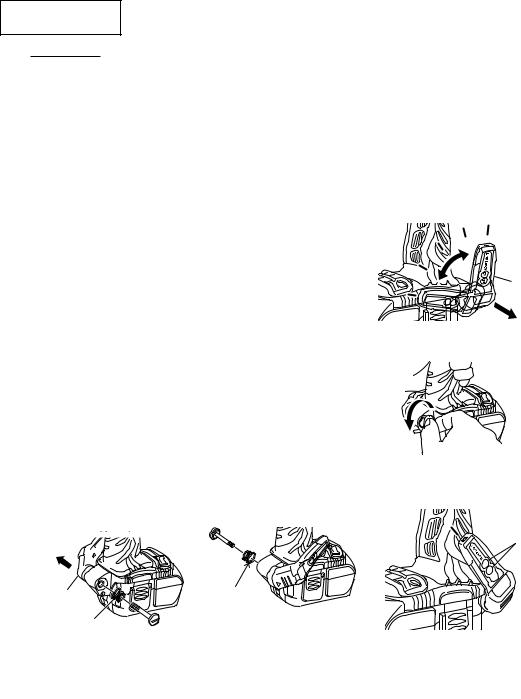
English
OPERATION
1.Using the light equipped hook
CAUTION:
●Do not attach the tip tool to the tool main unit when carrying the tool main unit with the light equipped hook suspended from a waist belt.
Such action could result in injury.
The light equipped hook has the following two functions:
It can be used as a hook for suspending from a waist belt when required by the nature of the work.
It can be used as an auxiliary light for such operations as tightening screws in a dark place.
1.1Using the hook
The hook can be installed on the right or left side and the angle can be adjusted in 5 steps between 0° and
|
80°. |
|
4 |
5 |
(1) |
Operating the hook |
|
||
|
|
|||
|
(a) Pull out the hook toward you in the direction of arrow (A) and turn |
|
3 |
|
|
in the direction of arrow (B). (Fig. 2) |
|
|
|
|
(b) The angle can be adjusted in 5 steps (0°, 20°, 40°, 60°, 80°). |
|
2 |
|
|
Adjust the angle of the hook to the desired position for use. |
|
|
|
(2) |
|
(B) |
|
|
Switching the hook position |
1 |
|
Hook |
|
|
CAUTION: |
|
||
● |
If the tool falls, there is a risk that malfunction and/or physical damage |
|
|
|
|
can occur. It is recommended that you also use fall-preventing wires, |
|
|
(A) |
|
etc. |
|
Fig. 2 |
|
● |
Incomplete installation of the hook may result in bodily injury when |
|
|
|
|
|
|
used.
(a) Securely hold the main unit and remove the screw using a slotted head screwdriver or a coin. (Fig. 3)
(b) Remove the hook and spring. (Fig. 4)
(c) Install the hook and spring on the other side and securely fasten with screw. (Fig. 3)
NOTE: Pay attention to the spring orientation. Install the spring with larger diameter away from you. (Fig. 5)
1.2 Using as an auxiliary light |
|
Fig. 3 |
|
(1) Press the switch to turn off the light. |
|||
|
|||
If forgotten, the light will turn off automatically after 15 minutes. |
|
||
(2) The direction of the light can be adjusted within the range of hook |
|
||
positions 1 – 5. (Fig. 6) |
|
3 |
|
|
|
||
|
|
Switch |
|
|
Larger |
|
|
|
diameter faces |
|
|
Spring |
away |
|
|
Fig. 5 |
|
||
Fig. 4 |
Fig. 6 |
||
|
|
||
Lighting time
AAAA manganese batteries: approx. 15 hrs. AAAA alkali batteries: approx. 30 hrs.
CAUTION:
●Do not look directly into the light. Such actions could result in eye injury.
10
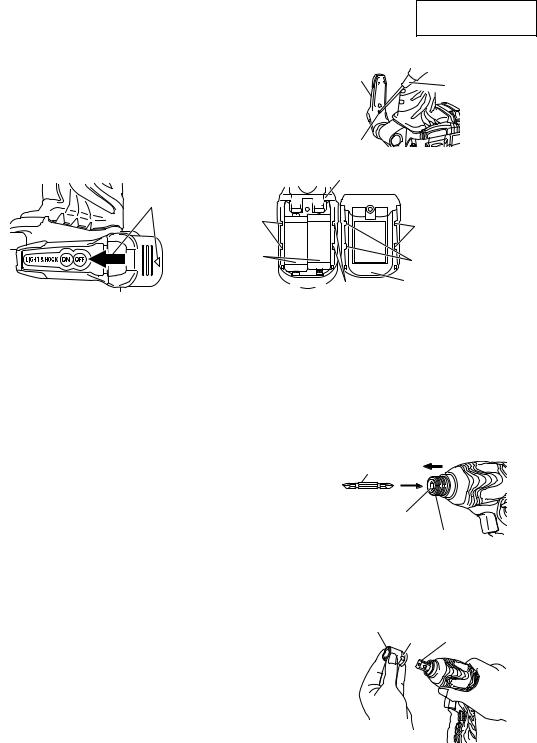
English
1.3 Replacing the batteries
(1)Loosen the hook screw with a Phillips-head screwdriver (No. 1). (Fig. 7) Hook Remove the hook cover by pushing in the direction of the arrow. (Fig. 8)
(2)Remove the old batteries and insert the new batteries. Align with the hook indications and position the plus (+) and minus (–) terminals correctly. (Fig. 9)
(3)Align the indentation in the hook main body with the protuberance of
the hook cover, press the hook cover in the direction opposite to that of Screw  the arrow shown in Fig. 8 and then tighten the screw.
the arrow shown in Fig. 8 and then tighten the screw.  Use commercially available AAAA batteries (1.5 V).
Use commercially available AAAA batteries (1.5 V).
|
Hook |
Arrow |
, . |
|
Indentation |
|
AAAA |
|
batteries |
|
. , Indentation |
Phillips-head screwdriver
Fig. 7
Protuberance
Protuberance
Hook cover
Fig. 8 |
Fig. 9 |
NOTE: Do not tighten the screw excessively. Such action could strip the screw threads.
CAUTION:
●Failure to observe the following can result in battery leakage, rust or malfunction. Position the plus (+) and minus (–) terminals correctly.
Replace both batteries at the same time. Do not mix old and new batteries. Remove exhausted batteries from the hook immediately.
●Do not discard batteries together with normal trash and do not throw batteries into fire.
●Store batteries out of the reach of children.
●Use batteries correctly in accordance with the battery specifications and indications.
2.Installing the bit (Impact driver)
|
Always follow the following procedure to install driver bit. (Fig. 10) |
Movement |
|
(1) |
Pull the guide sleeve back. |
Driver bit |
|
(2) |
Insert the bit into the hexagonal hole in the anvil. |
|
|
(3) |
Release the guide sleeve and it returns to its original position. |
|
|
|
CAUTION: |
|
|
● |
If the guide sleeve does not return to its original position, then the bit |
Hexagonal hole |
|
3. |
is not installed properly. |
in the anvil Guide sleeve |
|
Removing the bit (Impact driver) |
|
||
|
Please do the opposite point on the method of installing bit. |
Fig. 10 |
|
4. |
Selecting the socket matched to the bolt (Impact wrench) |
||
|
|||
|
Be sure to use a socket which is matched to the bolt to be tightened. Using an improper socket will not only |
||
|
result in insufficient tightening but also in damage to the socket or nut. |
||
|
A worn or deformed hex. or square-holed socket will not give an adequate tightness for fitting to the nut or |
||
|
anvil, consequently resulting in loss of tightening torque. |
Hexagonal socket |
|
|
Pay attention to wear of socket hole, and replace before further wear |
||
|
Groove Anvil |
||
|
has developed. |
||
5. |
Installing a socket (Impact wrench) |
|
|
|
Align the plunger located in the square part of the anvil with the hole in |
|
|
|
the hex. socket. Then push the plunger, and mount the hex. socket on |
|
|
|
the anvil. Check that the plunger is fully engaged in the hole. When |
|
|
|
removing the socket, reverse the sequence. (Fig. 11) |
|
|
6.Retaining ring type (Impact wrench)
(1)Align the square portions of the socket and the anvil with each other.
(2)Make sure to firmly install the socket by pushing it all the way into the
anvil.
(3) When removing the socket, pull it out of the anvil.
11
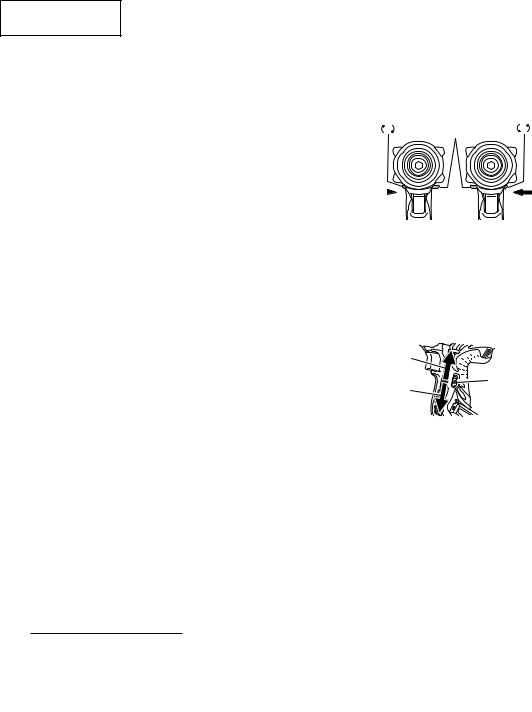
English
CAUTION:
●Please use the designated attachments which are listed in the operations manual and Hitachi’s catalog. Accidents or injuries could result from not doing so.
●Make sure to firmly install the socket in the anvil. If the socket is not firmly installed it might come out and cause injuries.
7. |
Confirm that the battery is mounted correctly |
|
R |
|
8. |
Check the rotational direction |
|
||
|
|
|
||
|
The bit rotates clockwise (viewed from the rear side) by pushing the R- |
|
|
|
|
side of the push button. |
|
|
|
|
The L-side of the push button is pushed to turn the bit counterclockwise. |
|
|
|
|
(See Fig. 12) |
|
|
|
|
CAUTION: |
Push |
||
●The push button can not be switched while the impact driver is turning. To switch the push button, stop the impact driver, then set the push button.
9.Switch operation
Push button |
L |
Push
Fig. 12
When the trigger switch is depressed, the tool rotates. When the trigger is released, the tool stops.
The rotational speed can be controlled by varying the amount that the trigger switch is pulled. Speed is low when the trigger switch is pulled slightly and increases as the trigger switch is pulled more.
NOTE: A buzzing noise is produced when the motor is about to rotate; this is only a noise, not a machine failure.
10. |
Change rotation speed |
|
|
|
As shown in Fig.13, when the rotation switch-over lever is slid to the |
|
|
|
lower side, the power mode (P) is set. And when slid to upper side, the |
Save |
|
|
save mode (S) is set. |
mode (S) |
|
|
Please use the save mode (S) when you want to lower Maximum |
Rotation |
|
|
tightening torque. |
Power |
switch-over |
|
CAUTION: |
mode (P) |
lever |
● |
In the work of the save mode (S), avoid the continuous screw-tightening |
|
|
|
as temperature of electronic components of the converter switch |
|
|
increases.
11. Tightening and loosening screws
Install the bit that matches the screw, line up the bit in the grooves of the head of the screw, then tighten it. Push the impact driver just enough to keep the bit fitting the head of the screw.
CAUTION:
●Applying the impact driver for too long tightens the screw too much and can break it.
●Tightening a screw with the impact driver at an angle to that screw can damage the head of the screw and the proper force will not be transmitted to the screw.
Tighten with this impact driver lined up straight with the screw.
12.Tightening and loosening bolts
A hex. socket matching the bolt or nut must first be selected. Then mount the socket on the anvil, and grip the nut to be tightened with the hex. socket. Holding the wrench in line with the bolt, press the power switch to impact the nut for several seconds.
If the nut is only loosely fitted to the bolt, the bolt may turn with the nut, therefore mistaking proper tightening. In this case, stop impact on the nut and hold the bolt head with a wrench before restarting impact, or manually tighten the bolt and nut to prevent them slipping.
OPERATIONAL CAUTIONS
1.Resting the unit after continuous work
After use for continuous bolt-tightening work, rest the unit for 15 minutes or so when replacing the battery. The temperature of the motor, switch, etc. will rise if the work is started again immediately after battery replacement, eventually resulting in burnout.
CAUTION:
Do not touch the protector, as it gets very hot during continuous work.
2.Cautions on use of the speed control switch
This switch has a built-in, electronic circuit which steplessly varies the rotation speed. Consequently, when the switch trigger is pulled only slightly (low speed rotation) and the motor is stopped while continuously
12 driving in screws, the components of the electronic circuit parts may overheat and be damaged.

English
3.Use a tightening time suitable for the screw
The appropriate torque for a screw differs according to the material and size of the screw, and the material being screwed etc., so please use a tightening time suitable for the screw. In particular, if a long tightening time is used in the case of screws smaller than 5/16” (8 mm), there is a danger of the screw breaking, so please confirm the tightening time and the tightening torque beforehand.
4.Work at a tightening torque suitable for the bolt under impact
The optimum tightening torque for nuts or bolts differs with material and size of the nuts or bolts. An excessively large tightening torque for a small bolt may stretch or break the bolt. The tightening torque increases in proportionate to the operation time. Use the correct operating time for the bolt.
5.Holding the tool
Hold the impact wrench firmly with both hands. In this case hold the wrench in line with the bolt.
It is not necessary to push the wrench very hard. Hold the wrench with a force just sufficient to counteract the impact force.
6.Confirm the tightening torque
The following factors contribute to a reduction of the tightening torque. So confirm the actual tightening torque needed by screwing up some bolts before the job with a hand torque wrench. Factors affecting the tightening torque are as follows.
(1)Voltage
When the discharge margin is reached, voltage decreases and tightening torque is lowered.
(2)Operating time
The tightening torque increases when the operating time increases. But the tightening torque does not increase above a certain value even if the tool is driven for a long time.
(3)Diameter of bolt
The tightening torque differs with the diameter of the bolt. Generally a larger diameter bolt requires larger tightening torque.
(4)Tightening conditions
The tightening torque differs according to the torque ratio, class, and length of bolts even when bolts with the same size threads are used. The tightening torque also differs according to the condition of the surface of workpiece through which the bolts are to be tightened. When the bolt and nut turn together, torque is greatly reduced.
(5)Using optional parts (Impact wrench)
The tightening torque is reduced a little when an extension bar, universal joint or a long socket is used.
(6)Clearance of the socket (Impact wrench)
A worn or deformed hex. or a square-holed socket will not give an adequate tightness to the fitting between the nut or anvil, consequently resulting in loss of tightening torque.
Using an improper socket which does not match to the bolt will result in an insufficient tightening torque.
MAINTENANCE AND INSPECTION
CAUTION:
Pull out battery before doing any inspection or maintenance.
1.Checking the condition of the bit (Impact driver)
The bits should be checked regularly. If worn or broken bits can slip or decrease the efficiency of the motor and burn it out. Replace worn bits with new ones.
CAUTION:
If you use a driver bit of which point is worn or broken, it will be dangerous since it slips. So replace it with a new one.
2.Checking the condition of the socket (Impact wrench)
A worn or deformed hex. or a square-holed socket will not give an adequate tightness to the fitting between the nut or anvil, consequently resulting in loss of tightening torque. Pay attention to wear of a socket holes periodically, and replace with a new one if needed.
3.Check the Screws
Loose screws are dangerous. Regularly inspect them and make sure they are tight.
CAUTION:
Using this power tool with loosened screws is extremely dangerous.
4.Maintenance of the motor
The motor unit winding is the very “heart” of the power tool.
Exercise due care to ensure the winding does not become damaged and/or wet with oil or water.
13
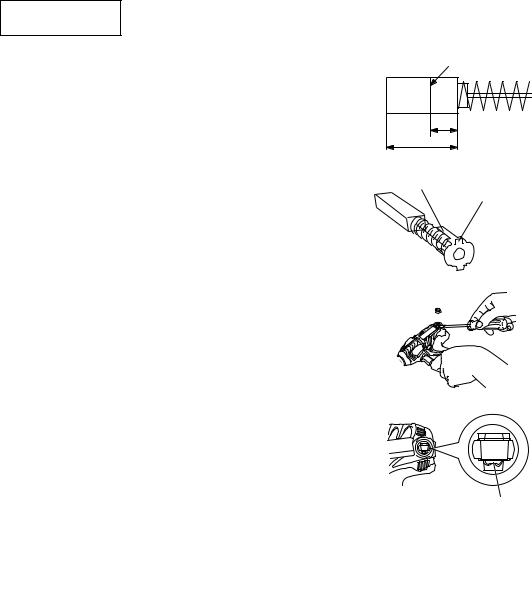
English
5.Inspecting the carbon brushes (Fig. 14)
The motor employs carbon brushes which are consumable parts. Since and excessively worn carbon brush can result in motor trouble, replace the carbon brush with new ones when it becomes worn to or near the “wear limit”. In addition, always keep carbon brushes clean and ensure that they slide freely within the brush holders.
NOTE: When replacing the carbon brush with a new one, be sure to use the Hitachi Carbon Brush Code No. 999054.
6.Replacing carbon brushes
Take out the carbon brush by first removing the brush cap and then hooking the protrusion of the carbon brush with a flat head screw driver, etc., as shown in Fig. 16.
When installing the carbon brush, choose the direction so that the nail of the carbon brush agrees with the contact portion outside the brush tube. Then push it in with a finger as illustrated in Fig. 17. Lastly, install the brush cap.
CAUTION:
●Be absolutely sure to insert the nail of the carbon brush into the contact portion outside the brush tube. (You can insert whichever one of the two nails provided.)
●Caution must be exercised since any error in this operation can result in the deformed nail of the carbon brush and may cause motor trouble at an early stage.
7.Check for Dust
Dust may be removed with a soft cloth or a cloth dampened with soapy water.
Do not use bleach, chlorine, gasoline or thinner, for they may damage the plastics.
8.Disposal of the exhausted battery
WARNING:
Do not dispose of the exhausted battery. The battery must explode if it is incinerated. The product that you have purchased contains a rechargeable battery. The battery is recyclable. At the end of it’s useful life, under various state and local laws, it may be illegal to dispose of this battery into the municipal waste stream. Check with your local solid waste officials for details in your area for recycling options or proper disposal.
9.Storage
Storing in a place below 104°F (40°C) and out of the reach of children.
Wear limit
3mm |
11.5mm |
Fig. 14
Nail of carbon brush
Protrusion of carbon brush
Fig. 15
Fig. 16
Contact portion outside brush tube Fig. 17
10.Service and repairs
All quality power tools will eventually require servicing or replacement of parts because of wear from normal use. To assure that only authorized replacement parts will be used, all service and repairs must be performed by a HITACHI AUTHORIZED SERVICE CENTER, ONLY.
11.Service parts list
CAUTION:
●Repair, modification and inspection of Hitachi Power Tools must be carried out by a HITACHI AUTHORIZED
SERVICE CENTER.
This Parts List will be helpful if presented with the tool to the HITACHI AUTHORIZED SERVICE CENTER when requesting repair or other maintenance. In the operation and maintenance of power tools, the safety regulations and standards prescribed in each country must be observed.
MODIFICATIONS:
Hitachi Power Tools are constantly being improved and modified to incorporate the latest technological advancements.
Accordingly, some parts may be changed without prior notice.
14

English
ACCESSORIES
WARNING:
ALWAYS use Only authorized HITACHI replacement parts and accessories. NEVER use replacement parts or accessories which are not intended for use with this tool. Contact HITACHI if you are not sure whether it is safe to use a particular replacement part or accessory with your tool.
The use of any other attachment or accessory can be dangerous and could cause injury or mechanical damage.
NOTE: Accessories are subject to change without any obligation on the part of the HITACHI.
STANDARD ACCESSORIES |
|
|
1 |
Battery Charger (UC14YFA or UC24YFA or UC18YG or UC18YRL) ....... |
1 |
2 |
Plastic Case (Code No. 323230) .......................................................... |
1 |
NOTE: Specifications are subject to change without any obligaition on the part of the HITACHI. |
||
15

Français
INFORMATIONS IMPORTANTES DE SÉCURITÉ
Lire et comprendre toutes les précautions de sécurité, les avertissements et les instructions de fonctionnement dans ce mode d’emploi avant d’utiliser ou d’entretenir cet outil motorisé.
La plupart des accidents causés lors de l’utilisation ou de l’entretien de l’outil motorisé proviennent d’un non respect des règles ou précautions de base de sécurité. Un accident peut la plupart du temps être évité si l’on reconnaît une situation de danger potentiel avant qu’elle ne se produise, et en observant les procédures de sécurité appropriées.
Les précautions de base de sécurité sont mises en évidence dans la section “SECURITE” de ce mode d’emploi et dans les sections qui contiennent les instructions de fonctionnement et d’entretien.
Les dangers qui doivent être évités pour prévenir des blessures corporelles ou un endommagement de la machine sont identifiés par AVERTISSEMENTS sur l’outil motorisé et dans ce mode d’emploi.
NE JAMAIS utiliser cet outil motorisé d’une manière qui n’est pas spécifiquement recommandée par HITACHI.
SIGNIFICATION DES MOTS D’AVERTISSEMENT
AVERTISSEMENT indique des situations potentiellement dangereuses qui, si elles sont ignorées, pourraient entraîner la mort ou de sérieuses blessures.
ATTENTION indique des situations dangereuses potentilles qui, si elles ne sont pas évitées, peuvent entraîner de mineures et légères blessures ou endommager la machine.
REMARQUE met en relief des informations essentielles.
SECURITE
REGLES GENERALE DE SECURITE – POUR TOUS LES OUTILS FONCTIONNANT SUR BATTERIE
AVERTISSEMENT:
Lire et coxmprendre toutes les instructions.
Un non respect de toutes les instructions ci-dessous peut entraîner une électrocution, un incendie et/ou de sérieuses blessures personnelles.
CONSERVER CES INSTRUCTIONS
1.Zone de travail
(1)Garder la zone de travail propre et bien éclairée. Les établis mal rangés et les zones sombres invitent aux accidents.
(2)Ne pas utiliser les outils motorisés dans une atmosphère explosive, telle qu’en présence de liquides inflammables, de gaz ou de poussières. Les outils motorisés créent des étincelles qui risquent d’enflammer la poussière ou les vapeurs.
(3)Tenir les spectateurs, les enfants et les visiteurs éloignés, lors de l’utilisation de l’outil motorisé. Une distraction peut faire perdre le contrôle de la machine.
2.Sécurité électrique
(1)Un outil motorisé à batterie avec batterie intégrée ou batterie séparée ne devra être rechargé qu’avec le chargeur spécialement conçu pour la batterie. Un chargeur qui convient pour un type de batterie donné peut présenter un risque de feu s’il est utilisé avec une autre batterie.
(2)Utiliser l’outil motorisé à batterie exclusivement avec la batterie spécialement conçue. L’utilisation de toute autre batterie peut présenter un risque de feu.
3.Sécurité personnelle
(1)Rester sur ses gardes, regarder ce que l’on fait et utiliser son sens commun lors de l’utilisation d’un outil motorisé. Ne pas utiliser un outil en état de fatigue ou sous l’influence de drogues, d’alcool ou de médicaments. Un moment d’inattention lors de l’utilisation de l’outil motorisé peut entraîner de sérieuses blessures personnelles.
(2)S’habiller correctement. Ne pas porter des vêtements larges ou des bijoux. Attacher les cheveux longs. Tenir ses cheveux, vêtements et ses gants éloignés des parties mobiles. Les vêtements larges, les bijoux et les cheveux longs peuvent se prendre dans les parties mobiles.
(3)Eviter tout démarrage accidentel. S’assurer que le l’interrupteur d’alimentation est sur la position d’arrêt avant de brancher la machine. Transporter l’appareil avec les doigts sur l’interrupteur d’alimentation ou brancher un outil avec l’interrupteur sur la position marche invite aux accidents.
(4)Retirer les clefs d’ajustement ou les commutateurs avant de mettre l’outil sous tension. Une clef qui est laissée attachée à une partie tournante de l’outil peut provoquer une blessure personnelle.
16
